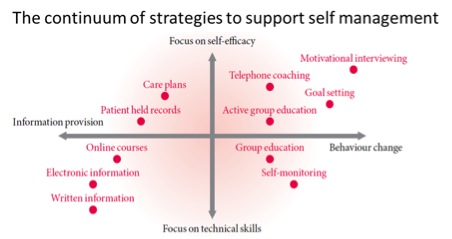Treatment Considerations in Disasters and Conflicts
Original Editors - Add your name/s here if you are the original editor/s of this page. User Name
Top Contributors - Naomi O'Reilly, Kim Jackson, Jess Bell, Rucha Gadgil and Ewa Jaraczewska
Introduction[edit | edit source]
Add your content to this page here!
Education[edit | edit source]
Add your content to this page here!
Self-Management[edit | edit source]
Self-management, incorporating active involvement of in decisions about treatment and shared responsibility has become more part of rehabilitation for individuals with long term neurological conditions. Understanding what it is and why it is becoming such a key element of the rehabilitation process are important to ensuring your treatment has patient involvement and is patient focused. Read the following resources on Self Management.[1][2]
Self-management is a model of care in which patients are encouraged to use strategies and learn skills to manage their own health needs [3]. Patients are active participants and take responsibility for their own health care behaviours, a notion that is lost in the medical model and passive therapies [4]. Recently, the WHO defined self- management as:
“the ability of individuals, families and communities to promote health, prevent disease, and maintain health…..to cope with illness and disability with or without the support of a health-care provider.”[5]
The Scottish Government has dedicated £6 million over the past three years to the Long Term Conditions Alliance Scotland in their promotion of self-management. The document “Gaun Yersel” was developed in alliance with patients and outlines the responsibilities and commitments of the government in combination with their 2020 Vision whereby individuals and communities aim to achieve social change.
Swan 2012 highlights the paradigm shift in health care from the concept that the patient’s health is the responsibility of the health care professional to ‘My health is my responsibility, and I have the tools to manage it’ [6]. The NHS must continue to make the transition from a ‘sickness’ service to a ‘well-being’ service.
Lorig et al (2003)[7]. explain that “wellness” from self-management requires attention in three key domains: the medical, behavioural, and emotional elements of a person’s life. They recognise that physiotherapists do not have extensive training in each domain, but they stress that physiotherapists’ expertise in exercise therapy, pain management, and healthy lifestyles promotion enables the profession to play a key role in supported self-management.
According to Phillips (2012) [8], a person needs to learn a range of skills to manage the biological, mental, emotional, and social impacts of their condition, including the effects of physical inactivity on health. This is termed the “biopsychosocial approach.” The following diagram depicts the range of strategies available to support the use of self-management:
|
Figure 1: The Health Foundation Evidence: Helping People Help Themselves, May 2011[9] |
Promoting Independence[edit | edit source]
Psychological Support[edit | edit source]
Psychol ogical first aid (PFA), describes a humane, supportive response to a fellow human being who is suffering and who may need support. PFA involves the following themes:
- providing practical care and support, which does not intrude;
- assessing needs and concerns;
- helping people to address basic needs (for example, food and water, information);
- listening to people, but not pressuring them to talk;
- comforting people and helping them to feel calm;
- helping people connect to information, services and social supports;
- protecting people from further harm
Psychosocial Support[edit | edit source]
Peer Support[edit | edit source]
Peer means the group of people who have faced the same kind of trauma. During the assessment, if the patient feels comfortable being with the peer group, the therapist can offer the option to the patient.[5] Many patients may have little knowledge regarding their pain experience as some pain might be due to emotional suffering and central sensitization.[10]Peer support might provide emotional support and it can be provided face to face, in a group, or via the internet as per the patient's choice.[11]
Resources[edit | edit source]
References [edit | edit source]
- ↑ Mudge, S. et al, Who is in Control? Clinicians’ View on their Role in Self-management Approaches: A Qualitative Metasynthesis , BMJ Open, 2015
- ↑ Jones, F. Chapter 19: Self-management , in Stokes, M. &s Stack, E., Physical Management for Neurological Conditions, Churchill Livingstone, 2013.
- ↑ Oliveira VC, Ferreira PH, Maher CG, Pinto RZ, Refshauge KM, Ferreira ML. Effectiveness of self‐management of low back pain: Systematic review with meta‐analysis. Arthritis care & research. 2012 Nov;64(11):1739-48.
- ↑ Harding V, Watson PJ. Increasing activity and improving function in chronic pain management. Physiotherapy. 2000 Dec 1;86(12):619-30.
- ↑ 5.0 5.1 Cite error: Invalid
<ref>tag; no text was provided for refs named:0 - ↑ Swan M. Sensor mania! the internet of things, wearable computing, objective metrics, and the quantified self 2.0. Journal of Sensor and Actuator networks. 2012 Dec;1(3):217-53.
- ↑ Lorig KR, Holman HR. Self-management education: history, definition, outcomes, and mechanisms. Annals of behavioral medicine. 2003 Aug 1;26(1):1-7.
- ↑ Phillips J. The need for an integrated approach to supporting patients who should self manage. Self Care. 2012;3:33-41.
- ↑ Health Foundation., 2011. The Health Foundation Evidence: Helping People Help Themselves [online]. . [Viewed 06 Nov 2014] Available from: http://renaltsar.blogspot.co.uk/2011/12/what-is-selfmanagement-support.html
- ↑ Cite error: Invalid
<ref>tag; no text was provided for refs named:1 - ↑ Cite error: Invalid
<ref>tag; no text was provided for refs named:2







